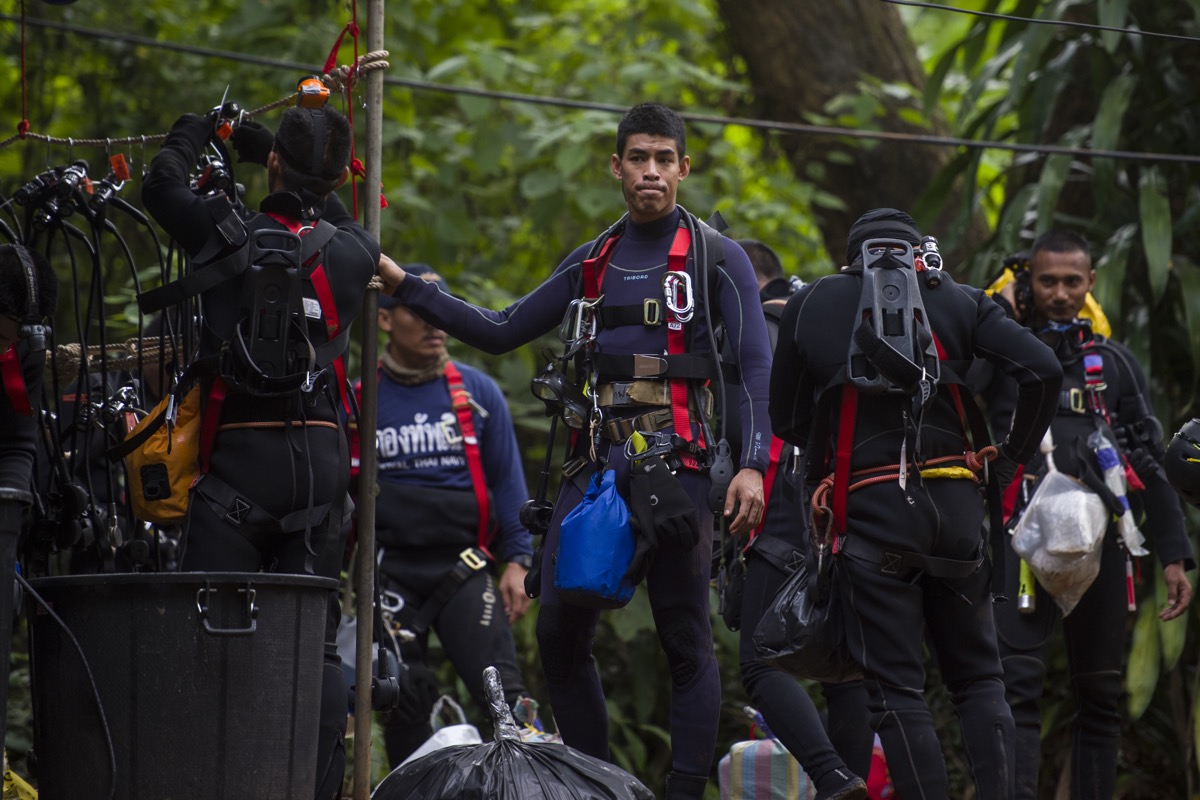The Very Real Risks of Rescuing the Boys Trapped in a Thai Cave

A massive operation is underway to rescue 12 boys and their 25-year-old soccer coach who have been trapped for nearly two weeks in the Tham Luang cave system, with rain expected Sunday (July 8).
Highlighting the treacherous nature of this rescue mission and cave diving in general, 38-year-old former Thai navy SEAL diver Saman Gunan (also reported as "Kunan") died early today (July 6) in a narrow passage in the cave on his way back from delivering oxygen to the boys. He reportedly ran out of oxygen.
And with rain on its way, the dangers are mounting. More than 1,000 people, from military officers to volunteers, are involved in saving the soccer team, news reports suggest. But every rescue option comes with risks. [The 7 Longest Caves in the World]
Wait it out?
Right now, officials are pumping water out of the cave where the boys are trapped. "The problem still is that you've got other inputs [of water] into the cave," George Veni, executive director of the National Cave and Karst Research Institute and president of the International Union of Speleology, told Live Science. Veni added that a map of the cave system revealed a large stream inside the complex that is downstream from where water is being pumped out.
And then, he said, there are all the cracks and crevices in cave walls that can not only drip but also pour in water from various locations.
Whether the team could wait out the monsoon season, remaining holed up in the cave for months, is not clear.
"I've heard mixed reports on how much the cave floods," Veni said. "If additional rains happen, I've heard reports that where they're at will get completely flooded, or they could wait it out for four months until after the monsoons."
Get the world’s most fascinating discoveries delivered straight to your inbox.
According to technical cave diver Edd Sorenson, a regional coordinator in Florida for the nonprofit International Underwater Cave Rescue and Recovery, it would take a lot of water, an amount that would bring the water level up more than 12 feet or so, to fill the cave chamber completely. "The chances of it completely filling, that's a lot of water, I can't imagine that ever happening," Sorenson said.
Even if this wait-it-out option were possible, the team would need a lot of supplies to stay alive.
"The challenge, though, is keeping people supplied with food and clean water and addressing their medical needs," Veni said. It's not a trivial challenge to get the divers, and supplies, to the chamber where the kids are waiting.
Another issue with "waiting it out" seems to be the oxygen levels. According to a report by the BBC, the oxygen concentration in the chamber's air — which should be at 21 percent — has dropped to 15 percent. The SEALs have started pumping oxygen into the cave chamber, CNN reported yesterday (July 5).
Even so, they will need to keep both the oxygen well above 10 percent and the carbon dioxide (CO2) down below 10 percent, Sorenson told Live Science. "If the oxygen level gets below 10 percent, you're dead; if you get CO2 above 10 percent, you're dead," said Sorenson, who is also the safety officer for the National Speleological Society-Cave Diving Section.
That's where CO2 scrubbers, which clear out the gas, come into play. Though they aren't commercially sold, Sorenson said that they are available: The space shuttle and submarines, for instance, use these scrubbers, he said. "Cave divers in the states have made their own CO2 scrubbers," he added.
(Sorenson is on standby if he is asked to help with the rescue; apparently, one needs an official invite from the Thai government to assist the rescue effort.)
Tricky dive rescue
A dangerous dive extraction seems to be the best option right now, as there is a "limited amount of time" to rescue the team, said Arpakorn Yookongkaew, Thailand's Navy SEAL commander, News.com reported.
Teaching the basics of diving to the boys and getting them out, possibly each with a couple of expert divers guiding them, comes with a lot of risks.
News reports suggest that the boys are located about 2.5 miles (4 kilometers) into the cave, and while Veni thinks that is likely horizontal distance, it could also refer to depth.
"Diving in caves is very risky; it's very unforgiving. If something goes wrong, you can't go up for air," Veni said. "In case of an emergency, you may have to swim underwater for 10 minutes and do some underwater gymnastics to get through a narrow space and get up to air."
Then, there's the additional challenge of near-zero visibility. "You're in total darkness; essentially, you're swimming through mud," he said.
"The fact that you can't see where you're going adds to the discomfort that someone who's not trained will have," Veni added. "If you have a problem, you can't see how to fix it; you can't see someone with you, and they can't see you have a problem."
The water, especially in the narrow passageways, is likely churning violently as well, Sorenson said, recalling a cave he calls "screwdriver cave," because he had to dig in with screwdrivers to actually make his way through the system, as the water was flowing so forcefully. In a video clip of rescuers walking into the Tham Luang cave complex, the water flow is so violent it nearly knocked them over, and that was a relatively "dry" part of the cave, Sorenson said.
Besides not having any experience with diving, the boys are also weak from malnutrition and likely are somewhat dehydrated due to diarrhea, Veni noted. Two of the boys and the coach are suffering from "exhaustion from malnutrition," according to a doctor's report, CNN noted.
"They have all had dysentery of some sort because they're drinking muddy water; there's going to be bacteria in it," Veni said.
Drill extraction
Earlier this week, reports suggested that a rescue team was also exploring the idea of extracting the boys through a natural or drilled hole into the mountain.
The soccer team had said they heard sounds — from chickens, kids playing, a rooster and a barking dog — which might suggest a natural shaft extending into the cave. But, Veni said, they were very likely imagining those sounds. "Those noises are almost certainly their imagination. I've been in many caves with flowing water, and when we turn off our lights, [with] the sound of water moving through a cave, you would swear that someone is walking down the passage, walking up to you," Veni explained.
To drill into the mountain in the right place, officials would need to take a transmitter into the cave where the boys are located, where the device would then transmit their precise location to the surface, Veni said. But the mountain that holds the cave complex looks steep, and it would take a major effort — it could require workers excavating a road to the correct spot — to get a drill rig to the right location and establish a flat area to work from, he added.
Original article on Live Science.
Jeanna Bryner is managing editor of Scientific American. Previously she was editor in chief of Live Science and, prior to that, an editor at Scholastic's Science World magazine. Bryner has an English degree from Salisbury University, a master's degree in biogeochemistry and environmental sciences from the University of Maryland and a graduate science journalism degree from New York University. She has worked as a biologist in Florida, where she monitored wetlands and did field surveys for endangered species, including the gorgeous Florida Scrub Jay. She also received an ocean sciences journalism fellowship from the Woods Hole Oceanographic Institution. She is a firm believer that science is for everyone and that just about everything can be viewed through the lens of science.
